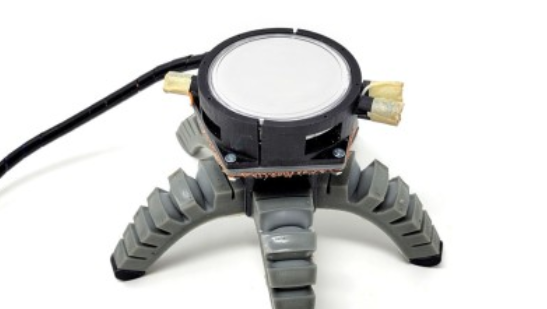Potential Applications: The biohybrid robots powered by mycelium signals represent a step forward in creating robots that can autonomously navigate and adapt to unpredictable environments. Future applications could include agricultural robots that monitor soil chemistry and determine the optimal time to apply fertilizers, potentially reducing environmental impacts like harmful algal blooms Technology Networks
Researchers from Cornell University and the University of Florence have developed biohybrid robots that use fungal mycelium and its innate electrical signals to move and interact with their environment. These biohybrid robots, which combine biological and synthetic components, can perform tasks with minimal supervision by harnessing the unique properties of mycelium. Rob Shepherd, the senior author of the study, explains that by integrating mycelium into the robot’s electronics, these machines can sense and respond to environmental stimuli. In their latest experiments, the researchers used light as an input, prompting the spider-shaped robot to move and crawl like a jellyfish in response.
Why is it that scientists appear to NEVER HAVE WATCHED OR READ ANY SCIENCE FICTION HORROR!
Biohybrid robots controlled by electrical impulses — in mushrooms | Cornell Chronicle https://t.co/ejtFydEK0O
— Scribbler (@scwhorf) September 4, 2024
The use of mycelium in biohybrid robots could lead to significant advancements in agricultural technology. For example, these robots could be deployed to detect soil chemistry in row crops, autonomously deciding when and where to add fertilizer based on their assessments. The mycelium’s electrical signals act as the “brain” of these robots, enabling them to respond to environmental conditions and make decisions independently, effectively giving them a form of rudimentary intelligence.
The research team, including Anand Kumar Mishra, Jaeseok Kim, Hannah Baghdadi, Bruce R. Johnson, Kathie T. Hodge, and Robert F. Shepherd, leveraged the mycelium’s natural ability to sense chemical and biological signals. Lead author Anand Mishra developed an interface device capable of reading the mycelium’s electrical signals while filtering out interference from external factors like vibrations and electromagnetic fields. Additionally, Mishra designed a controller inspired by Central Pattern Generators, which are neural networks in animals responsible for generating rhythmic signals for repetitive movements, such as walking and breathing. This controller converts the mycelium’s electrical signals into digital commands that are then sent to the robots’ actuators, enabling them to perform specific actions like crawling or rolling.
Integration of Mycelium and Robotics: Researchers grew mycelium into the electronics of robots, allowing these biohybrid machines to sense and react to environmental changes. Mycelium was chosen due to its ability to grow in harsh conditions and its natural capacity to sense chemical and biological signals, making it ideal for integration into robotic systemsCornell Chronicle and Technology Networks
To date, the researchers have created two types of biohybrid robots: a soft, spider-like robot that mimics the movement of a jellyfish, and a wheeled robot. These robots have successfully completed three sets of experiments. In the first experiment, they responded to the mycelium’s electrical signals, moving in different ways based on the input received. In the second experiment, the researchers introduced ultraviolet light, which altered the robots’ movements upon exposure, demonstrating the mycelium’s ability to perceive and react to environmental changes.
Cornell researchers have integrated fungal mycelia into biohybrid robots, allowing them to react to their environment more effectively. This groundbreaking approach opens up possibilities for robots to sense and respond to their surroundings in new ways.#robotics #robot pic.twitter.com/JvQ2laOYiE
— Tech Explorist (@TechExplorist) September 4, 2024
In a third experiment, the researchers took direct control by replacing or suppressing the mycelium’s natural electrical signals with their own inputs, showing that these biohybrid robots can be externally directed. Anand Mishra emphasized that the project is not just about controlling a robot but also about creating a meaningful connection with a living system. By interpreting the signals from the mycelium, researchers can understand the environmental stressors or conditions affecting the organism, which are then visualized through the robot’s movements.
This groundbreaking research indicates that mycelium-powered biohybrid robots could have numerous applications, from agriculture to environmental monitoring. By growing mycelium within these robots, the machines gain the ability to sense, respond, and adapt to their surroundings, potentially leading to more autonomous and environmentally integrated robotics.
Key Points:
i. Researchers have developed biohybrid robots powered by fungal mycelium’s electrical signals, allowing them to sense and respond to environmental stimuli.
ii. The mycelium-based robots could be used in agriculture to detect soil chemistry and autonomously decide when and where to apply fertilizer.
iii. The team created two robot prototypes that mimic jellyfish-like movements and respond to environmental inputs such as light.
iv. Experiments showed that the robots could be externally controlled by manipulating the mycelium’s electrical signals.
v. The research highlights the potential for a deeper connection between biological systems and robotics, paving the way for autonomous, environmentally-aware machines.
Kirk Volo – Reprinted with permission of Whatfinger News



